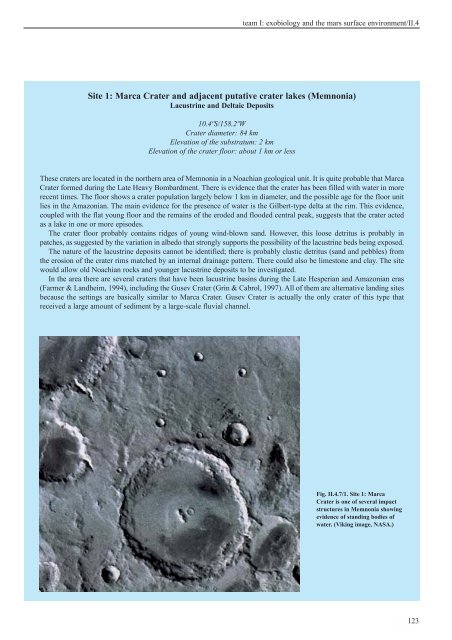Exobiology in the Solar System & The Search for Life on Mars - ESA
Exobiology in the Solar System & The Search for Life on Mars - ESA
Exobiology in the Solar System & The Search for Life on Mars - ESA
You also want an ePaper? Increase the reach of your titles
YUMPU automatically turns print PDFs into web optimized ePapers that Google loves.
team I: exobiology and <str<strong>on</strong>g>the</str<strong>on</strong>g> mars surface envir<strong>on</strong>ment/II.4<br />
Site 1: Marca Crater and adjacent putative crater lakes (Memn<strong>on</strong>ia)<br />
Lacustr<str<strong>on</strong>g>in</str<strong>on</strong>g>e and Deltaic Deposits<br />
10.4ºS/158.2ºW<br />
Crater diameter: 84 km<br />
Elevati<strong>on</strong> of <str<strong>on</strong>g>the</str<strong>on</strong>g> substratum: 2 km<br />
Elevati<strong>on</strong> of <str<strong>on</strong>g>the</str<strong>on</strong>g> crater floor: about 1 km or less<br />
<str<strong>on</strong>g>The</str<strong>on</strong>g>se craters are located <str<strong>on</strong>g>in</str<strong>on</strong>g> <str<strong>on</strong>g>the</str<strong>on</strong>g> nor<str<strong>on</strong>g>the</str<strong>on</strong>g>rn area of Memn<strong>on</strong>ia <str<strong>on</strong>g>in</str<strong>on</strong>g> a Noachian geological unit. It is quite probable that Marca<br />
Crater <str<strong>on</strong>g>for</str<strong>on</strong>g>med dur<str<strong>on</strong>g>in</str<strong>on</strong>g>g <str<strong>on</strong>g>the</str<strong>on</strong>g> Late Heavy Bombardment. <str<strong>on</strong>g>The</str<strong>on</strong>g>re is evidence that <str<strong>on</strong>g>the</str<strong>on</strong>g> crater has been filled with water <str<strong>on</strong>g>in</str<strong>on</strong>g> more<br />
recent times. <str<strong>on</strong>g>The</str<strong>on</strong>g> floor shows a crater populati<strong>on</strong> largely below 1 km <str<strong>on</strong>g>in</str<strong>on</strong>g> diameter, and <str<strong>on</strong>g>the</str<strong>on</strong>g> possible age <str<strong>on</strong>g>for</str<strong>on</strong>g> <str<strong>on</strong>g>the</str<strong>on</strong>g> floor unit<br />
lies <str<strong>on</strong>g>in</str<strong>on</strong>g> <str<strong>on</strong>g>the</str<strong>on</strong>g> Amaz<strong>on</strong>ian. <str<strong>on</strong>g>The</str<strong>on</strong>g> ma<str<strong>on</strong>g>in</str<strong>on</strong>g> evidence <str<strong>on</strong>g>for</str<strong>on</strong>g> <str<strong>on</strong>g>the</str<strong>on</strong>g> presence of water is <str<strong>on</strong>g>the</str<strong>on</strong>g> Gilbert-type delta at <str<strong>on</strong>g>the</str<strong>on</strong>g> rim. This evidence,<br />
coupled with <str<strong>on</strong>g>the</str<strong>on</strong>g> flat young floor and <str<strong>on</strong>g>the</str<strong>on</strong>g> rema<str<strong>on</strong>g>in</str<strong>on</strong>g>s of <str<strong>on</strong>g>the</str<strong>on</strong>g> eroded and flooded central peak, suggests that <str<strong>on</strong>g>the</str<strong>on</strong>g> crater acted<br />
as a lake <str<strong>on</strong>g>in</str<strong>on</strong>g> <strong>on</strong>e or more episodes.<br />
<str<strong>on</strong>g>The</str<strong>on</strong>g> crater floor probably c<strong>on</strong>ta<str<strong>on</strong>g>in</str<strong>on</strong>g>s ridges of young w<str<strong>on</strong>g>in</str<strong>on</strong>g>d-blown sand. However, this loose detritus is probably <str<strong>on</strong>g>in</str<strong>on</strong>g><br />
patches, as suggested by <str<strong>on</strong>g>the</str<strong>on</strong>g> variati<strong>on</strong> <str<strong>on</strong>g>in</str<strong>on</strong>g> albedo that str<strong>on</strong>gly supports <str<strong>on</strong>g>the</str<strong>on</strong>g> possibility of <str<strong>on</strong>g>the</str<strong>on</strong>g> lacustr<str<strong>on</strong>g>in</str<strong>on</strong>g>e beds be<str<strong>on</strong>g>in</str<strong>on</strong>g>g exposed.<br />
<str<strong>on</strong>g>The</str<strong>on</strong>g> nature of <str<strong>on</strong>g>the</str<strong>on</strong>g> lacustr<str<strong>on</strong>g>in</str<strong>on</strong>g>e deposits cannot be identified; <str<strong>on</strong>g>the</str<strong>on</strong>g>re is probably clastic detritus (sand and pebbles) from<br />
<str<strong>on</strong>g>the</str<strong>on</strong>g> erosi<strong>on</strong> of <str<strong>on</strong>g>the</str<strong>on</strong>g> crater rims matched by an <str<strong>on</strong>g>in</str<strong>on</strong>g>ternal dra<str<strong>on</strong>g>in</str<strong>on</strong>g>age pattern. <str<strong>on</strong>g>The</str<strong>on</strong>g>re could also be limest<strong>on</strong>e and clay. <str<strong>on</strong>g>The</str<strong>on</strong>g> site<br />
would allow old Noachian rocks and younger lacustr<str<strong>on</strong>g>in</str<strong>on</strong>g>e deposits to be <str<strong>on</strong>g>in</str<strong>on</strong>g>vestigated.<br />
In <str<strong>on</strong>g>the</str<strong>on</strong>g> area <str<strong>on</strong>g>the</str<strong>on</strong>g>re are several craters that have been lacustr<str<strong>on</strong>g>in</str<strong>on</strong>g>e bas<str<strong>on</strong>g>in</str<strong>on</strong>g>s dur<str<strong>on</strong>g>in</str<strong>on</strong>g>g <str<strong>on</strong>g>the</str<strong>on</strong>g> Late Hesperian and Amaz<strong>on</strong>ian eras<br />
(Farmer & Landheim, 1994), <str<strong>on</strong>g>in</str<strong>on</strong>g>clud<str<strong>on</strong>g>in</str<strong>on</strong>g>g <str<strong>on</strong>g>the</str<strong>on</strong>g> Gusev Crater (Gr<str<strong>on</strong>g>in</str<strong>on</strong>g> & Cabrol, 1997). All of <str<strong>on</strong>g>the</str<strong>on</strong>g>m are alternative land<str<strong>on</strong>g>in</str<strong>on</strong>g>g sites<br />
because <str<strong>on</strong>g>the</str<strong>on</strong>g> sett<str<strong>on</strong>g>in</str<strong>on</strong>g>gs are basically similar to Marca Crater. Gusev Crater is actually <str<strong>on</strong>g>the</str<strong>on</strong>g> <strong>on</strong>ly crater of this type that<br />
received a large amount of sediment by a large-scale fluvial channel.<br />
Fig. II.4.7/1. Site 1: Marca<br />
Crater is <strong>on</strong>e of several impact<br />
structures <str<strong>on</strong>g>in</str<strong>on</strong>g> Memn<strong>on</strong>ia show<str<strong>on</strong>g>in</str<strong>on</strong>g>g<br />
evidence of stand<str<strong>on</strong>g>in</str<strong>on</strong>g>g bodies of<br />
water. (Vik<str<strong>on</strong>g>in</str<strong>on</strong>g>g image, NASA.)<br />
123

















